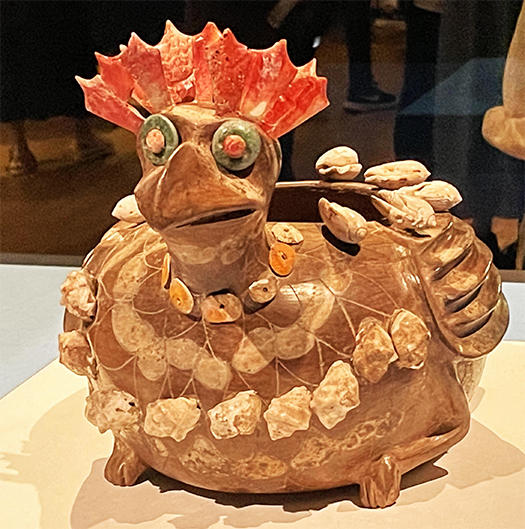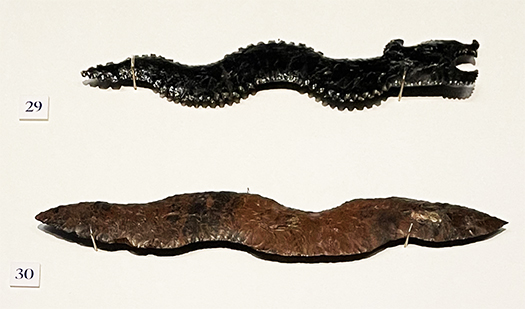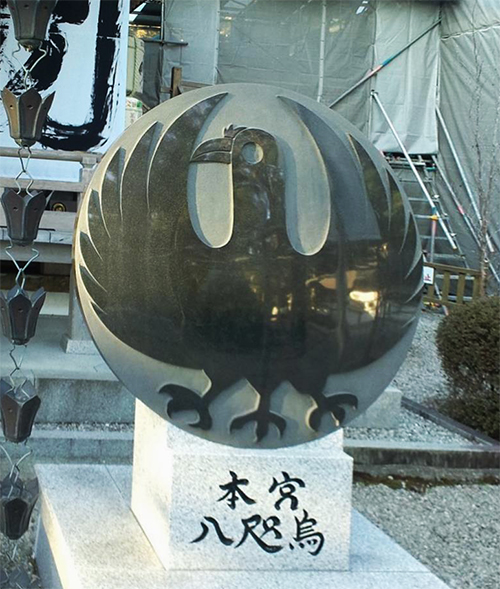

古代メキシコの西暦紀元前100年前後から紀元後500年に栄えていたテオティワカンでは、宗教的ピラミッドなどからいろいろな動物をかたどった偶像が発見される。
上の写真はそのなかでも展示会で目を見張らされた極彩色の「鳥形土器」。発見者によって「奇妙なアヒル」と名付けられた。はじめてこういう造形と遭遇したときの驚き感がよくわかる。貝などの華美な装飾を持った「容器」とされる。このテオティワカンは2000mを超える高地の宗教都市だというので、地元周辺からは貝などは産出されない。したがって、この内陸部とメキシコ湾岸部社会との交易を担った貝商人、というビジネスが成立していた可能性があり、かれらから副葬品として献上されたものではないかと解説されていた。被葬者への葬送として動物種に意味があったと推測される。
その下の写真は「ヘビ型エキセントリック(両面加工石器)」と同じ用途を持った「ナイフ型エキセントリック」。テオティワカンの「月のピラミッド」からの出土品。エキセントリックとは、細かな剥離によって複雑なカタチを作った石器。埋葬墓からはこうした動物造形の副葬品が多量に出土するという。初源的自然信仰がかれらの文化の基本的特徴と思えるけれど、そういった動物を形象させて普遍的な「コトバ」コミュニケーションツールとして伝えたものかも知れない。
ヘビを造形することで、なにか宗教的なメッセージ性をその道具に持たせたのではないか。

ほぼ日本史での同時代としては神武東征という歴史譚が日本にはある。
たいへん印象的な動物説話として、ヤタガラス神話がある。写真は熊野本宮大社の3本足のカラス彫像。3本の足を持つカラスとして描かれるようになったのは、中国神話に登場する3本足のカラス説話が朝鮮半島を経て日本に伝わったことの影響とされる。
神武天皇は東方に天下を治める都を造ろうと大和に向かう。瀬戸内海を渡り難波から淀川を溯上、河内に入り大和に向かおうとしたが、大和の豪族のナガスネビコの迎撃にあい敗戦、撤退。神武はこの敗戦を太陽女神アマテラスの子孫であるにもかかわらず太陽に向かって、西から東に向いて戦ったためと考え、紀伊半島を南に迂回して熊野から北上して大和に侵入することを目指す。
そのときに天から舞い降りたヤタガラスが、熊野の山中を迷いなく進軍させて吉野川のほとりにたどりついたのだとされる。日本の説話に残る動物譚としてはこのヤタガラス神話が白眉だろう。
動物にある種の呪術的な意味を持たせ権威装飾の物語性を付与させるという手法。日本民族の事例から考えれば、古代メキシコでも同様の意味合いが付与されていると思える。古代ローマでも皇帝の始祖はオオカミに育てられたという神話。たぶんそのような経緯が古代メキシコでもあったに違いない。
それにしてもこの奇妙なアヒルの始原的なユーモア感覚は卓越している。深く心に突き刺さってアタマから離れない(笑)。
English version⬇
Animal Idols and Yatagarasu at Teotihuacan, Ancient Mexico – 5
Strange ducks and snakes. Animal symbolism adorns the discourse. Ancient Mexico is characterized by an outstanding sense of modeling. Can the yatagarasu barely compete with them?
In Teotihuacan, which flourished in ancient Mexico from around 100 B.C. to 500 A.D., idols in the shape of various animals have been found in religious pyramids and other structures.
The photo above shows one of the most eye-catching finds at the exhibition, an extremely colored “bird-shaped” earthenware vessel. It was named “strange duck” by the discoverer. I can understand the sense of surprise when one encounters such a form for the first time. It is believed to be a “vessel” with ornate decorations such as shells. Teotihuacan is said to be a religious city at a high altitude of over 2,000 meters, so shells are not produced in the local area. Therefore, it is possible that a business of shell merchants, who were in charge of trade between the inland area and the Gulf Coast society, was established, and that these vessels were offered as burial accessories by these merchants. It is assumed that the animal species had a meaning as a funerary offering to the deceased.
The photo below shows a “knife-shaped eccentric” that had the same purpose as the “snake-shaped eccentric (two-sided processed stone tool). Excavated from the “Pyramid of the Moon” at Teotihuacan. Eccentric is a stone tool with a complex shape created by fine peeling. It is said that a large amount of such animal-shaped artifacts have been excavated from burial tombs. While primordial nature beliefs seem to be a fundamental characteristic of their culture, it is possible that they used such animal figures as universal “vocabulary” communication tools.
By modeling snakes, they may have given the tools some kind of religious message.
Japan has a historical tale of the Jinmu expedition, which is almost contemporaneous with Japanese history.
One of the most impressive animal tales is the myth of the raven. The three-legged raven, depicted in the three-legged raven statue at Kumano Hongu Taisha Shrine, is said to have been inspired by the three-legged raven myths of Chinese mythology, which came to Japan via the Korean Peninsula.
Emperor Jinmu headed for Yamato in an attempt to build a capital to rule the country in the east. He crossed the Seto Inland Sea, went up the Yodo River from Namba, entered Kawachi, and attempted to go to Yamato, but was defeated and retreated when he was intercepted by Nagasunebiko, a powerful Yamato tribe. Jinmu attributed this defeat to the fact that although he was a descendant of the sun goddess Amaterasu, he fought from the west to the east, facing the sun, and thus he sought to invade Yamato by detouring southward through the Kii Peninsula and then northward from Kumano.
It is said that a raven descended from the heavens at that time and marched without hesitation through the mountains of Kumano to reach the banks of the Yoshino River. The myth of the raven is probably the most famous animal tale in Japanese folklore.
The technique of giving animals a kind of magical meaning and narrative of authority and ornamentation. In the case of the Japanese people, it is likely that similar meanings were given to animals in ancient Mexico as well. In ancient Rome, the myth that the founder of the emperor was raised by wolves. Perhaps such a story must have existed in ancient Mexico as well.
Still, the primordial sense of humor of this strange duck is outstanding. It sticks deeply in my mind and won’t leave my head (laughs).
Posted on 9月 21st, 2023 by 三木 奎吾
Filed under: 歴史探訪







コメントを投稿
「※誹謗中傷や、悪意のある書き込み、営利目的などのコメントを防ぐために、投稿された全てのコメントは一時的に保留されますのでご了承ください。」
You must be logged in to post a comment.